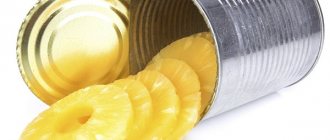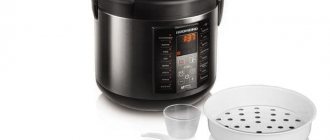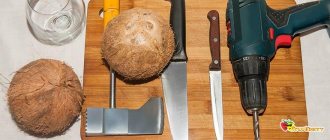- Posted by Svetlana Grishkina
- Date: September 28, 2018
Screw-on canning jars have become very popular these days. They are very convenient, easy to use, and save time and effort compared to seaming machines. But here’s the problem: screwing such a jar is as easy as shelling pears, but opening it is often very difficult. Why this happens and how to cope with such a nuisance - we’ll talk about this in today’s article.
- 2 How to easily deal with a twist-off lid
2.1 Photo gallery: helpers in opening screw-on glass jars
Why don't they open?
Reusable twist-off screw lids for canning are very convenient. The principle of their operation is quite simple: when heated with hot water or steam, the polymer coating on the inside of the lid becomes softer, due to which the jar closes tightly. After this, the lid begins to cool, its top retracts, creating a vacuum effect. In this case, a strip of polymer acts as a sealing gasket.
Glass jars with screw-on lids are the most popular today for storing a variety of pickles and preserves.
To reuse the cap, you need to unscrew it carefully. To do this, you can use a special key or open the jar with your hands very carefully, if, of course, you have enough strength. But more often than not, it is precisely these strengths that the hostess lacks, and a strong, muscular man is not always nearby. The reasons why the jar is difficult to open may be the following:
- slippery hands or jar surface;
- the lid fits tightly to the neck of the jar, simply sticking to it; this problem usually happens with jars of honey or jam;
- The pressure in the jar is below atmospheric, causing the lid to retract more than necessary.
Note! It is very important to know correctly which way to turn the lid. It closes clockwise and unscrews in the opposite direction.
Before you start unscrewing the lid, take a closer look at the entire jar: maybe you shouldn’t open it to serve the contents? If the lid is swollen, it means that the canned food has already spoiled. When unscrewed, the lid may even fly off the jar and hit you in the face, followed by the entire contents.
If you find a crack on the surface of the jar, then you should not open it either. Air may have gotten inside, spoiling the food; even worse - micro-shards of glass.
Safety precautions when opening a can without an opener
If you know how to open a can without a can opener, then still, do not forget about simple safety measures.
Safety regulations:
- Do not cut off the lid with a bread knife or anything with a serrated blade, as this will introduce metal shavings into your food;
- Do not open bloated, leaking, or exploded canned food and do not try to eat it - it is most likely lost and contains dangerous bacteria;
- If, when opening, the contents exploded or literally splashed out, that is, it’s also not worth it, since it’s gone;
- One way or another, all of the above methods involve a risk of injury, so they are not suitable for children;
- Do not rush to open canned food and do not neglect your protection if you do not use a can opener;
- And with a special device, there may be sawdust or shavings inside the jar - try to prevent them from getting in and immediately remove visible debris;
- Only open canned food in good light and on a flat, stable surface - do not do anything by weight.
How to easily deal with a screw cap
Most often, such jars open without much difficulty, but sometimes, no matter how hard you try, nothing works. One of my friends constantly performs a funny trick: with the words “Open up, police!” taps the lid with his finger, and then unscrews it with a slight movement of his hand. I don’t understand how she does this, it doesn’t work for me. But fortunately, there are many other proven methods.
- Use a special key . It's good if you have a special can opener for such lids in your kitchen drawer. It works both for twisting and unscrewing, without damaging either the glass of the jar or the lid. Maybe it’s worth purchasing it, especially since it’s so inexpensive?
- Hit. The easiest way to open a jar without a key is to turn it over and, holding it suspended, slap the bottom, or, conversely, place it on your palm and hit the lid. It almost always works, except in very difficult cases when the problem is not the vacuum, but the fact that the lid is stuck.
It’s worth knowing this secret: it’s better to twist the jar, not the lid.
- Increase the hitch . If the cause of difficulty is your hands slipping, proceed as follows. The jar, lid and hands should be dry and grease-free. Put a rubber or silicone glove on your hand (regular gloves you use when washing dishes work well). In mild cases, you can get by with a kitchen towel. Polyethylene film increases the grip of the lid and the hand very well. Sandpaper can also help. Place some kind of “gasket” on the lid and start unscrewing the jar from the lid, and not vice versa. True, you still have to apply a considerable amount of torque. And if your hands also hurt, then this method is definitely not for you.
- Use the laws of physics . Take a leather belt and thread it through the buckle. Throw the resulting loop over the lid and tighten it tightly, directing it counterclockwise. Then rotate so that the can goes clockwise and the lid goes counterclockwise.
- Knock . Gently tap the top and sides of the tight lid with something wooden or plastic - a spatula, the handle of a knife. Do this carefully so as not to damage the jar. If the reason is not that the lid is too worn in, after such manipulations the jar will open without difficulty.
- Take a ride . A simple method often helps: place the jar on its side, and roll the edge of the lid along the edge of the countertop several times back and forth, slightly pressing on top with your hand. The tightly pressed surface of the edge of the lid will relax a little, making a quiet pop, after which the jar will open quite easily.
- Heat. Fill a bowl with hot water and place the jar in it with the lid down. Leave it like this for 10 minutes, then remove it and open it. Running hot water will also work well if you place the illumination jar under an open tap. When exposed to heat, the lid expands and is easier to unscrew. You can also place a very hot towel on the lid. And the fastest way to heat the lid is boiling water: just pour it over the sink directly from the kettle for a few seconds.
Please use caution. If too hot water hits a very cold jar, the glass may crack.
- Depressurize. Is the problem that the cap has retracted too much under the vacuum? This means you need to ensure air access inside the can. Insert a table knife between the neck and the lid and carefully turn it a little, moving the edge of the lid to the side, away from the glass. A gap of 0.5 mm is enough for depressurization to occur.
You can do this with a can opener, or in general with any one that you don’t mind, but if you plan to use this jar with a lid further, it is better to take a table knife with a blunt rounded end - it will not damage the glass or scratch the lid.
- Lubricate the thread. For jars with honey and jam, this method is suitable: place the jar upside down, and drop a little vegetable oil in several places between the neck and the lid. Leave for 15–20 minutes. This time should be enough for the oil to penetrate into the cracks, lubricate the surfaces and make it easier to unscrew the lid.
By the way, this “oiling” also has a pleasant bonus: the oiled thread will not stick for a long time in the future. You just need to make sure that the oil does not get inside the product itself.
Photo gallery: Helpers for opening screw-on glass jars
Screw cap wrenches work on the principle of minimizing your effort to unscrew
Take a knife with a thick round tip to avoid chips and scratches, and pry the lid, letting air under it
Try opening a screw-top jar while wearing household gloves.
Vegetable oil perfectly lubricates the threads of a screw-on jar and makes unscrewing easier
The belt method is very old, but effective.
Hot water perfectly heats the lid and the air inside the jar, after which opening it will not be difficult
Methods for opening a tin can
The easiest way to open a tin can is with a standard opener. It is necessary to make a puncture with the tip, insert the knife of the tool there and open the container with penetrating translational movements. Instead of a can opener, you can use a regular table opener - the algorithm of actions is the same.
To understand how to open a can of canned food without special equipment, you need to understand its design. It consists of walls, a bottom and a lid, which is bent with a press around the base. This results in a protruding metal side. If you remove it, the can will open. Using pliers for this purpose, you just need to bend the edges of the side around the perimeter. You can even handle a tin can with a spoon or a flat stone:
- first you need to rub the tin with these objects;
- then, turning the jar over, move the edge in a circular motion along the stone or the entire perimeter of the spoon.
Aluminum cutlery is not suitable for opening cans. It is necessary to use a more durable material.
Is it necessary to turn such a preservation over?
Many people remember how parents, after screwing up the canned food, turn the jars over. It's amazing why you need to turn them upside down after seaming? Many housewives still cannot name the exact reasons for such manipulations. Some do it out of habit, others out of family tradition.
According to some housewives, the process of turning over jars with blanks is not mandatory; this is done to check the tightness of the sealed container. If liquid begins to flow out of an inverted jar or bubbles appear near the lid, this means that the jar is not closed tightly, which will allow air to pass through and the products will deteriorate.
If a leak is detected, it is necessary to sterilize the jars again and repeat the rolling process, thereby eliminating the possibility of food spoilage. However, you should be careful and pay attention to the manufacturers' recommendations. The packages often contain useful tips for proper use.
Depressurization
Due to the vacuum, the lid can be pulled in so tightly that normal twisting will not help. For depressurization, air will need to get inside the can. To do this, try to pry off the lid with a knife or other sharp object. There are also special devices for removing bottle caps. When you hear a pop, you can safely open it.
Special key
The key is a plastic rim and works on the principle of pliers. In addition to a strong clamp, the handles provide a lever effect.
To open the lid with it, you need to do the following:
- Place the rim on the lid.
- Squeeze the handles, reducing the rim diameter as much as possible.
- Without releasing the handles, turn the device counterclockwise.
The key has several internal diameters, so it can be applied to caps of different sizes. There are rubber linings inside that prevent the key from slipping around the cover.
Hot water
A possible problem with a non-opening lid is sticking. This happens if the jar contains, for example, honey or jam. You can solve this problem like this:
- Heat the water and pour it into a wide container.
- Holding the jar tightly with the lid down, lower it into the water.
- Remove the lid from the water periodically, being careful not to overheat it.
- Turn over and place on the table.
- Wipe the jar and open it.
You can also use simpler methods - place the lid under a stream of hot water or use a heated towel.
Important. Do not use hot boiling water! The jar may burst due to sudden heating.
Reducing slipping
Often the lid does not give way only because it slips in your hands. To do this, you need to remember the laws of physics or simply reduce the slip. There are several ways:
- a sheet of sandpaper must be placed with the abrasive side on the lid of the jar and opened, pressing firmly with your hand;
- cover the jar with any damp cloth or towel and try to unscrew the lid;
- Scotch tape or duct tape are also great helpers. Fold a piece of tape in half with the sticky side facing out and wrap it around the lid. Fingers will not be able to slip off the lid, and the jar will easily open;
- rubber gloves do a good job with this task, but before doing this, you must degrease the surface by wiping the jar with a towel or covering the lid with cling film;
- Rubber bands for money placed on the surface of the lid prevent your hands from slipping.
Mechanical keys
More complex mechanical designs are often used in catering establishments. A professional can opener is fixed to the edge of the table using screws or special clamps.
Homemade machines consist of two levers and a thumb, which, when turned, cuts off the lid of the can.
Advantages of a mechanical opener:
- High quality sharp blades, sharpened on both sides, made of hardened carbon steel.
- Rust-resistant mechanism.
- Plastic bushing that facilitates movement and reduces physical effort.
- Simplicity of design, allowing you to independently disassemble and reassemble the mechanism if necessary.
- Dishwasher safe.
Product expiration date
In closed packaging, the product can be stored for up to two years in glass containers, and up to one year in tin containers. Experts note that nine months from the date of manufacture the product begins to lose its properties. You can still use it, but the healing power is already minimal.
The shelf life of olive oil after opening is no more than a month. After this time, “liquid gold” loses its taste and most of its beneficial properties. You can store opened olive oil in a glass or tin container for a little more than a month if the container is tightly sealed.
You should not buy a large bottle for future use: the required volume should be determined by the monthly needs of the family.
Manual openers
Simple manual can openers are the most durable retro models, found everywhere since Soviet times. They consist of a handle - wooden or plastic, and a working part. The key has a sharpened blade and a small hook that is convenient for prying tin lids off glass jars.
Tapping
The knife can also be used with its other side.
Take a knife and tap the handle on the sides and top of the lid. This will help loosen the threads so the can will open faster.
Another ineffective, but worth mentioning method: sharply hit the bottom of the jar with your hand, holding it suspended.
Main conclusions
Every housewife has probably encountered difficulties when opening cans of preserved food. Of the presented methods, one will always lead to a positive result.
Before you start opening the jar, you should carefully inspect it. It may be worth abandoning this activity, since the products in it could become unusable. In any case, you first need to try to determine the reason why the jar cannot be opened. Based on this, it will be easier to choose a method and tools to solve this problem.
If you know of other simple methods, please share them in the comments. Good luck with canning and opening all your jars with ease!











